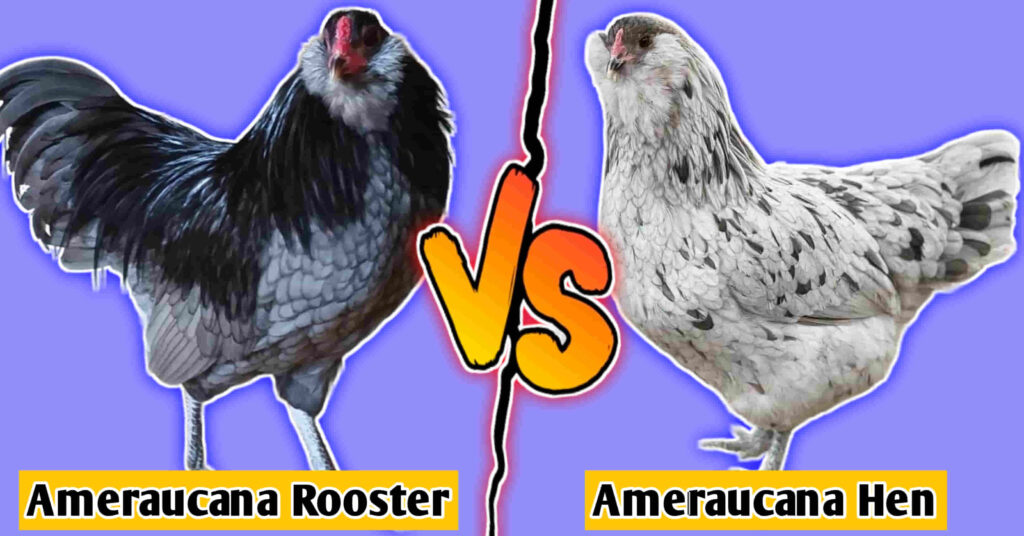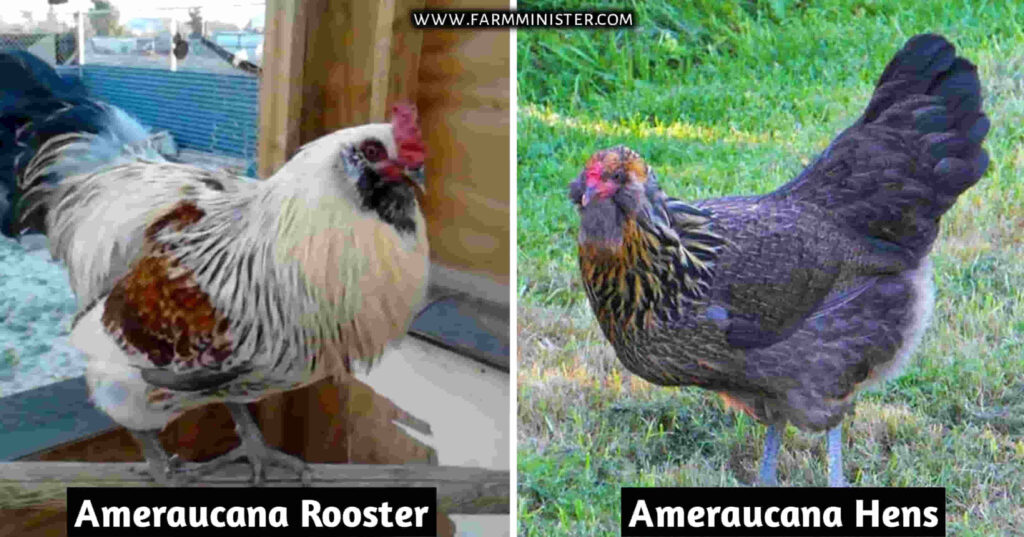When it comes to backyard chicken farmer or a poultry lover the Ameraucana chickens are become very popular among them due to their unique appearance and attractive blue eggs laying ability. If you thinking of raising this breed, let’s know about the Ameraucana rooster Vs hen, and which one will be right for your backyard flock.

Ameraucana Rooster Vs Hen
As Ameraucana chickens, Rooster are known for their charming personalities and hens are known for their blue color of eggs laying ability. As this is a dual-purpose chicken breed, which they can lay attractive blue eggs and good quality as well.
Within the Ameraucana breed flock, you will find both roosters and hens, and they both or each of them has unique characteristics and roles within the flock. Now let’s understand the between the Ameraucana rooster vs hen.
Read Also: Ameraucana Vs Easter Egger Chicken
| Feature | Ameraucana Rooster | Ameraucana Hen |
|---|---|---|
| Size | Larger | Smaller |
| Coloration | More brightly colored | More muted color |
| Feathers | Longer and more pointed feathers | Shorter and more rounded feathers |
| Comb and Wattles | Larger and more pronounced | Smaller and less pronounced |
| Behavior | More aggressive and territorial | More docile and laid-back |
| Egg Laying | Does not lay eggs | Lays 250 eggs per year (3-4 eggs per week) |
1) Appearance: Ameraucana Rooster vs Hen
I) Comb and Wattles:
One of the easiest way to make difference between a rooster from a hen is by looking at their heads. Roosters typically have much larger and brighter red combs compared to hens. These combs can be quite elaborate, with multiple points or ridges that stand upright.
II) Size and Build:
The Roosters are generally large in size with strong body. They also have attractive and muscular build, thicker legs, and stand tall with strong posture. On the other hand, the hens are small in size and more compact.
III) Plumage Color:
You can make difference very easily in Both the roosters and hens on your flock. As the roosters have bright and colorful feathers. While on the other hand, the hens have feathers in duller colors than the roosters, like brown or gray.
IV) Saddle Feathers:
The Roosters have long, pointy feathers on their backs that are often bright in color, especially during mating season. On the other hand, the Hens have short and plain feathers on their backs.
Read Also: 9 Free Natural Feeds for Chickens
2) Temperament: Ameraucana Rooster vs Hen

The temperament of an Ameraucana rooster Vs hen can vary depending on the individual chicken, however here are some of the key differences in temperament between Ameraucana rooster and hen:
I) Nature:
Like most chickens, Ameraucana roosters and hens are can be friendly in nature towards their owner and other chickens of the flock, especially if they’re raised from chicks and well-handled.
II) Noise:
Roosters are known for their crowing, which can be quite loud and occur throughout the day. On the other hand, Hens are generally quieter than roosters.
III) Active:
Both the gender (Rooster and hen) of the Ameraucana flock, that they are usually more active and alert, and always keep their eyes on any threats or danger to their flock.
IV) Productive:
Bothe the Rooster and hens are productive chicken, as roosters are able to produce good quality of meat. On the other hand, hens are able to lay around 250 attractive blue color of eggs throughout the year.
Read Also: 5 Best Egg Laying Chicken Breed
3) Purpose: Ameraucana Rooster vs Hen
As the Ameraucana Roosters and hens both has individual importance and roles into the flock. However, a Rooster is helping to produce meat and also mate with the hens to fertilizing the eggs, which lead expending the flock. On the other hand, hens are lay eggs, caring and rising their chicks and also can be use as meat purpose.
4) Lifespan: Ameraucana Rooster vs Hen
The lifespan of Ameraucana rooster Vs hen is generally similar, on average, Ameraucana chickens can live for about 6 to 8 years, but individual lifespans may vary. However, there are some factors that can affect the lifespan of chickens, such as: genetic, diet, living condition, stress level etc.
5) Body Growth: Ameraucana Rooster Vs Hen
The body growth of an Ameraucana roosters and hens is almost similar, but there are slight differences. Roosters are typically larger than hens. As a mature rooster can weight around 6.5-7 pounds. On the other hand, a hen can reach a mature weight around 5-5.5 pounds.
Conclusion
In conclusion, Ameraucana rooster and hen each have their own unique characteristics and roles in the flock. Roosters are larger, more protective, and primarily responsible for mating with the hens, while hens are known for their attractive blue egg-laying abilities.
Q1: Are Ameraucana chickens expensive?
Ans: Yes, Ameraucana chickens can be expensive.
Q2: Are Ameraucana roosters quiet?
Ans: Ameraucana roosters are generally quieter than other breeds of roosters.
Q3: Are Ameraucana roosters aggressive?
Ans: Ameraucana roosters are generally not as aggressive as other breeds of roosters.
Q4: How big do Ameraucana Roosters get?
Ans: Ameraucana roosters can reach their mature weight of 6.5-7 pounds.